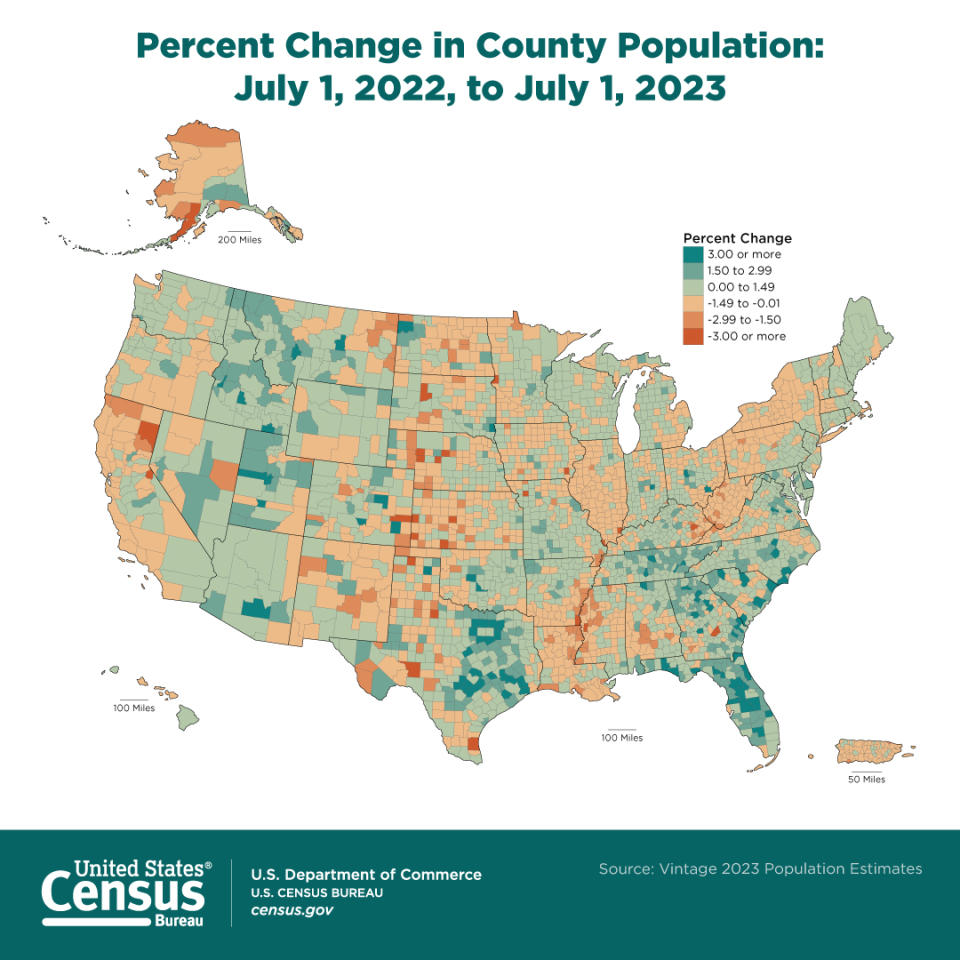Ian, other factors impeded Lee County population growth in 2023 after big jump in 2022

While Lee County gained in population between 2022 and 2023, a slowdown after COVID, Hurricane Ian walloping Southwest Florida and the sheer scale of the current population may have cut the rate of growth by more than half compared to years prior.
According to data released this month by the U.S. Census Bureau, while Lee’s population continued to grow by roughly 1,000 a month between 2022 and 2023, its growth rate slowed considerably.
Between 2021 and 2022, Lee added about 32,000 residents, or 2,666 residents per month through births and migration, a rate of nearly 4% growth. The year before, Lee grew by another 25,000 residents, or about 2,100 residents per month – a growth rate of 3.3%.
The rate of growth dropped to 1.5% from July 2022 to July 2023.
In 2020, Lee stood at 765,547 residents; by July of 2023, the population had grown to 834,573.
The Census Bureau bases population estimates on sources such as tax returns, Medicare enrollment data and Social Security data.
And though Lee’s population still saw net growth between 2022 and 2023, a high cost of living and Hurricane Ian’s devastation may have played a role in the decreased rate of growth as rebuild costs soared.
A report by the National Hurricane Center says Ian was responsible for 150 direct and indirect deaths and $112 billion in damages –– $109 billion of that done in Florida alone –– making it the costliest hurricane in Florida history. Ian's damage was concentrated primarily in Lee, Charlotte and Collier counties, and barrier islands like Sanibel, Pine Island and Fort Myers Beach were devastated by the storm surge, homes submerged beneath the water, some even ripped apart.
As of June 2023, just $16 billion of Ian-related losses were insured, Florida Office of Insurance Regulation data shows.
Sanibel Mayor Holly Smith suspected the decreased rate of growth was connected to a number of factors, including fewer people fleeing COVID restrictions for the sunny beaches of Florida, a higher cost of living, and a lack of sufficient housing.
"We had such an influx of people (from 2020 to 2022) coming to Florida during the COVID years and I think (the draw was) what Florida was doing a little bit differently," Smith said. "People wanted to be somewhere they weren't limited as strictly."
In 2022, Florida was named the fastest-growing state in the nation by the U.S. Census Bureau, the first time it had held that distinction since 1957. Between 2021 and 2022, Florida's population increased by 1.9% to 22,244,823 residents.
"The cost of living here could be a huge factor, too," said Smith. "People cannot afford to live in Lee County, and there's no housing for them to live here. We didn't have that glut maybe three years ago, but now we do. The wealthy will always be able to buy but there is a dearth of entry-level housing."
Indeed, the average cost of housing in Lee County is significantly higher than average. According to the Waller, Weeks and Johnson Rental Index, in February the average cost of a one-bedroom in the region remained at about $2,200. Average rent for a one-bedroom in the U.S. is just over $1,900 a month.
Across much of the country, rents have spiked, but incomes have not kept pace, leading to housing costs eating up an ever larger portion of household budgets. And in 2023, Cape Coral made the top-ten of cities in the U.S. with cost-burdened renters, which is defined as someone who pays more than 30% of their income in rent.
And, Smith added, Ian forced the cost of living and the cost of building up, making it hard for blue-collar retirees in places like Pine Island, Sanibel and Fort Myers Beach to rebuild.
After Ian destroyed their homes, many of them fled the area, Smith said, as they were often underinsured and were unable to rebuild.
"For Sanibel alone, many moved off the island, and they won't be back," Smith said.
The sheer size of the county may have also played a part in the slower growth rate. Lee County Property Appraiser Matt Caldwell said he had long anticipated a slowdown in new residents for just that reason.
“If you look at Dade, Broward, Palm Beach, Orange County, because they’re built out, their growth rate is relatively small,” Caldwell said. “We’re easily into the mid-800s, closing in on 900,000 people, I’ve always expected as we approach a million (residents), our growth would slow down because we’re closing in on build-out.”
[Source: U.S. Census Bureau]
Like Lee, Collier continued to grow in population, but on a much smaller scale than years previous.
Florida still a destination state
According to the release by the census, approximately 96% of Florida’s 67 counties grew from 2022 to 2023. Just three counties lost net population during the same time period.
Florida had four of the five fastest-growing U.S. metro areas between 2022 and 2023: Wildwood-The Villages at 4.7%; Lakeland-Winter Haven at 3.8%; Ocala at 3.4%; and Port St. Lucie at 3.1%.
Additionally, census data shows, Polk, Pasco and Marion counties topped the charts for domestic net migration. Polk saw an additional 26,000 people move to the area, while Pasco and Marion grew by roughly 24,000 and 15,000 respectively.
In total numeric growth, three Florida metro areas placed in the top 10. Orlando-Kissimmee-Sanford placed fourth, adding 54,916 for a population of 2,817,933. Tampa-St. Petersburg-Clearwater was fifth, adding 51,622 people for a total of 3,342,963. And Miami-Fort Lauderdale-West Palm Beach came in 10th with 43,387 more people, bring its population to 6,183,199.
Paul Nutcher of the Lakeland Ledger and Luis Zambrano of The News-Press contributed to this article.
This article originally appeared on Fort Myers News-Press: Lee County population grew to 835,000 in 2023 per the U.S. Census


